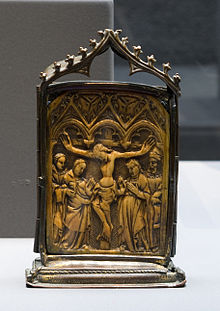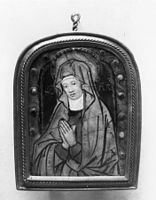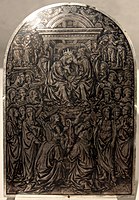
Vitreous enamel, also called porcelain enamel, is a material made by fusing powdered glass to a substrate by firing, usually between 750 and 850 °C. The powder melts, flows, and then hardens to a smooth, durable vitreous coating. The word comes from the Latin vitreum, meaning "glass".

A medal or medallion is a small portable artistic object, a thin disc, normally of metal, carrying a design, usually on both sides. They typically have a commemorative purpose of some kind, and many are presented as awards. They may be intended to be worn, suspended from clothing or jewellery in some way, although this has not always been the case. They may be struck like a coin by dies or die-cast in a mould.
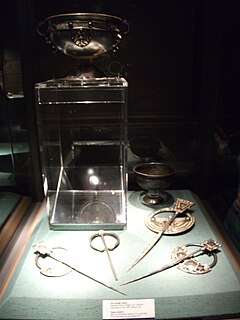
The Ardagh Hoard, best known for the Ardagh Chalice, is a hoard of metalwork from the 8th and 9th centuries. Found in 1868 by two young local boys, Jim Quin and Paddy Flanagan, it is now on display in the National Museum of Ireland in Dublin. It consists of the chalice, a much plainer stemmed cup in copper-alloy, and four brooches — three elaborate pseudo-penannular ones, and one a true pennanular brooch of the thistle type; this is the latest object in the hoard, and suggests it may have been deposited around 900 AD.

Objet d'art literally means "art object" in French, but in practice, the term has long been reserved in English to describe works of art that are not paintings, large or medium-sized sculptures, prints, or drawings. It therefore covers a wide range of works, usually small and three-dimensional, of high quality and finish in areas of the decorative arts, such as metalwork items, with or without enamel, small carvings, statuettes and plaquettes in any material, including engraved gems, hardstone carvings, ivory carvings and similar items, non-utilitarian porcelain and glass, and a vast range of objects that would also be classed as antiques, such as small clocks, watches, gold boxes, and sometimes textiles, especially tapestries. Books with fine bookbindings might be included.

Cloisonné is an ancient technique for decorating metalwork objects with colored material held in place or separated by metal strips or wire, normally of gold. In recent centuries, vitreous enamel has been used, but inlays of cut gemstones, glass and other materials were also used during older periods; indeed cloisonné enamel very probably began as an easier imitation of cloisonné work using gems. The resulting objects can also be called cloisonné. The decoration is formed by first adding compartments to the metal object by soldering or affixing silver or gold as wires or thin strips placed on their edges. These remain visible in the finished piece, separating the different compartments of the enamel or inlays, which are often of several colors. Cloisonné enamel objects are worked on with enamel powder made into a paste, which then needs to be fired in a kiln. If gemstones or colored glass are used, the pieces need to be cut or ground into the shape of each cloison.
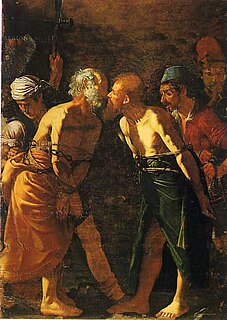
The kiss of peace is an ancient traditional Christian greeting, sometimes also called the "holy kiss", "brother kiss", or "sister kiss". Such greetings signify a wish and blessing that peace be with the recipient, and besides their spontaneous uses they have certain ritualized or formalized uses long established in liturgy. Many denominations use other forms of greeting to serve equivalent purposes; they include handshakes, gestures, and hugs, any of which may be called a sign of peace.

A reliquary is a container for relics. A portable reliquary may be called a fereter, and a chapel in which it is housed a feretory.

Niello is a black mixture, usually of sulphur, copper, silver, and lead, used as an inlay on engraved or etched metal, especially silver. It is added as a powder or paste, then fired until it melts or at least softens, and flows or is pushed into the engraved lines in the metal. It hardens and blackens when cool, and the niello on the flat surface is polished off to show the filled lines in black, contrasting with the polished metal around it. It may also be used with other metalworking techniques to cover larger areas, as seen in the sky in the diptych illustrated here. The metal where niello is to be placed is often roughened to provide a key. In many cases, especially in objects that have been buried underground, where the niello is now lost, the roughened surface indicates that it was once there.

Maso Tommasoii Finiguerra (1426–1464) was an Italian goldsmith, niellist, draftsman, and engraver working in Florence, who was incorrectly described by Giorgio Vasari as the inventor of engraving as a printmaking technique. This made him a crucial figure in the history of old master prints and remained widely believed until the early twentieth century. However, it was gradually realised that Vasari's view, like many of his assertions as to the origins of technical advances, could not be sustained. Typically, Vasari had overstated the importance of a fellow-Florentine, and a fellow-Italian, since it is now clear that engraving developed in Germany before Italy.
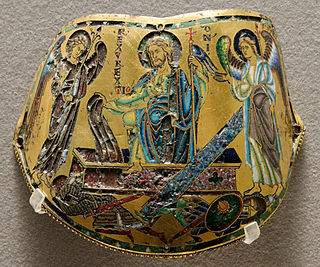
Champlevé is an enamelling technique in the decorative arts, or an object made by that process, in which troughs or cells are carved, etched, die struck, or cast into the surface of a metal object, and filled with vitreous enamel. The piece is then fired until the enamel fuses, and when cooled the surface of the object is polished. The uncarved portions of the original surface remain visible as a frame for the enamel designs; typically they are gilded in medieval work. The name comes from the French for "raised field", "field" meaning background, though the technique in practice lowers the area to be enamelled rather than raising the rest of the surface.

A plaquette is a small low relief sculpture in bronze or other materials. These were popular in the Italian Renaissance and later. They may be commemorative, but especially in the Renaissance and Mannerist periods were often made for purely decorative purposes, with often crowded scenes from religious, historical or mythological sources. Only one side is decorated, giving the main point of distinction with the artistic medal, where both sides are normally decorated. Most are rectangular or circular, but other shapes are found, as in the example illustrated. Typical sizes range from about two inches up to about seven across a side, or as the diameter, with the smaller end or middle of that range more common. They "typically fit within the hand", as Grove puts it. At the smaller end they overlap with medals, and at the larger they begin to be called plaques.
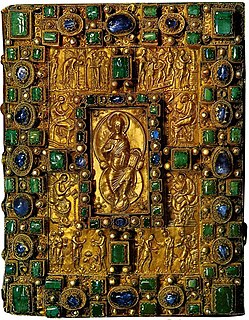
A treasure binding or jewelled bookbinding is a luxurious book cover using metalwork in gold or silver, jewels, or ivory, perhaps in addition to more usual bookbinding material for book-covers such as leather, velvet, or other cloth. The actual bookbinding technique is the same as for other medieval books, with the folios, normally of vellum, stitched together and bound to wooden cover boards. The metal furnishings of the treasure binding are then fixed, normally by tacks, onto these boards. Treasure bindings appear to have existed from at least Late Antiquity, though there are no surviving examples from so early, and Early Medieval examples are very rare. They were less used by the end of the Middle Ages, but a few continued to be produced in the West even up to the present day, and many more in areas where Eastern Orthodoxy predominated. The bindings were mainly used on grand illuminated manuscripts, especially gospel books designed for the altar and use in church services, rather than study in the library.

Basse-taille (bahss-tah-ee) is an enamelling technique in which the artist creates a low-relief pattern in metal, usually silver or gold, by engraving or chasing. The entire pattern is created in such a way that its highest point is lower than the surrounding metal. A translucent enamel is then applied to the metal, allowing light to reflect from the relief and creating an artistic effect. It was used in the late Middle Ages, and then again in the 17th century.

Ronde-bosse, en ronde bosse or encrusted enamel is an enamelling technique developed in France in the late 14th century that produces small three-dimensional figures, or reliefs, largely or entirely covered in enamel. The new method involved the partial concealment of the underlying gold, or sometimes silver, from which the figure was formed. It differs from older techniques which all produced only enamel on a flat or curved surface, and mostly, like champlevé, normally used non-precious metals, such as copper, which were gilded to look like gold. In the technique of enamel en ronde-bosse small figures are created in gold or silver and their surfaces lightly roughened to provide a key for the enamel, which is applied as a paste and fired. In places the framework may only be wire.

Limoges enamel has been produced at Limoges, in south-western France, over several centuries up to the present. There are two periods when it was of European importance. From the 12th century to 1370 there was a large industry producing metal objects decorated in enamel using the champlevé technique, of which most of the survivals, and probably most of the original production, are religious objects such as reliquaries.

A chasse, châsse or box reliquary is a shape commonly used in medieval metalwork for reliquaries and other containers. To the modern eye the form resembles a house, though a tomb or church was more the intention, with an oblong base, straight sides and two sloping top faces meeting at a central ridge, often marked by a raised strip and decoration. From the sides there are therefore triangular "gable" areas.
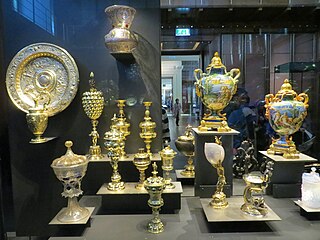
In 1898, Baron Ferdinand de Rothschild bequeathed to the British Museum as the Waddesdon Bequest the contents from his New Smoking Room at Waddesdon Manor. This consisted of a wide-ranging collection of almost 300 objets d'art et de vertu, which included exquisite examples of jewellery, plate, enamel, carvings, glass and maiolica. One of the earlier objects is the outstanding Holy Thorn Reliquary, probably created in the 1390s in Paris for John, Duke of Berry. The collection is in the tradition of a schatzkammer, or treasure house, such as those formed by the Renaissance princes of Europe; indeed, the majority of the objects are from late Renaissance Europe, although there are several important medieval pieces, and outliers from classical antiquity and medieval Syria.

Art in Medieval Scotland includes all forms of artistic production within the modern borders of Scotland, between the fifth century and the adoption of the Renaissance in the early sixteenth century. In the early Middle Ages, there were distinct material cultures evident in the different federations and kingdoms within what is now Scotland. Pictish art was the only uniquely Scottish Medieval style; it can be seen in the extensive survival of carved stones, particularly in the north and east of the country, which hold a variety of recurring images and patterns. It can also be seen in elaborate metal work that largely survives in buried hoards. Irish-Scots art from the kingdom of Dál Riata suggests that it was one of the places, as a crossroads between cultures, where the Insular style developed.

The Eberbach Pax is an early Renaissance pax and reliquary from Eberbach Abbey, which is now in the Limburg Cathedral Treasury. The pax was an object used in the Middle Ages and Renaissance for the Kiss of Peace in the Catholic Mass. Direct kissing among the celebrants and congregation was replaced by each in turn kissing the pax, which was carried around those present. The form of the pax was variable but normally included a flat surface to be kissed.
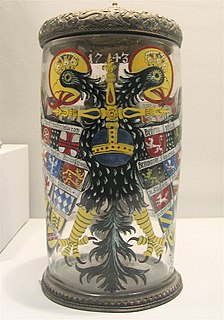
Enamelled glass or painted glass is glass which has been decorated with vitreous enamel and then fired to fuse the glasses. It can produce brilliant and long-lasting colours, and be translucent or opaque. Unlike most methods of decorating glass, it allows painting using several colours, and along with glass engraving, has historically been the main technique used to create the full range of image types on glass.
